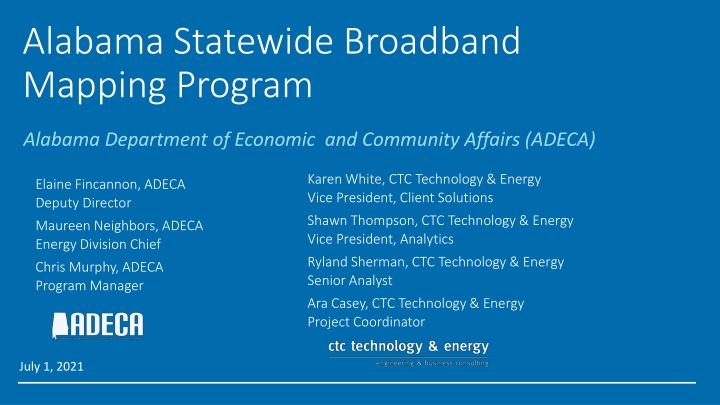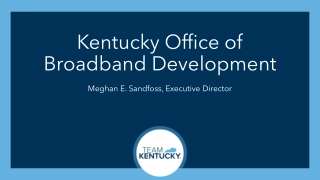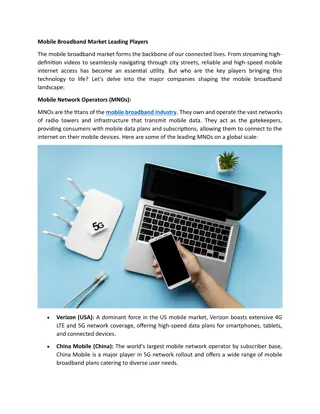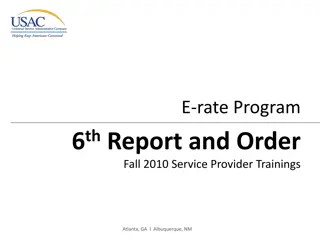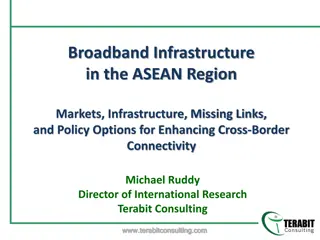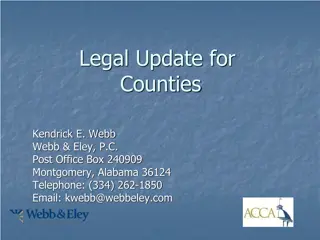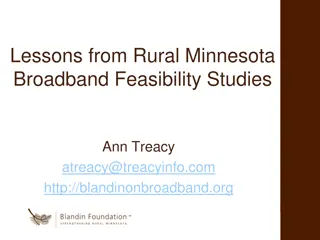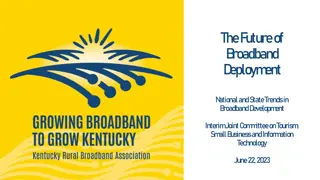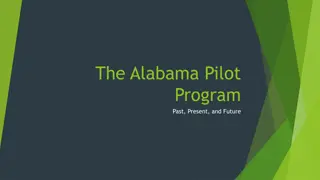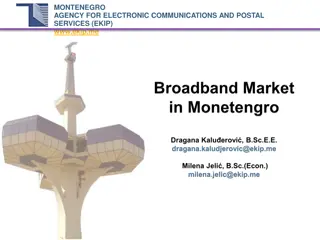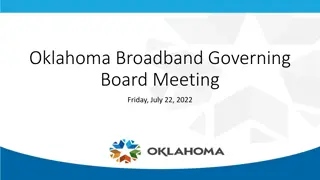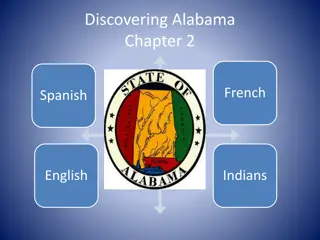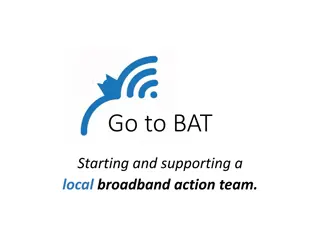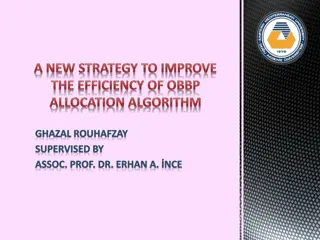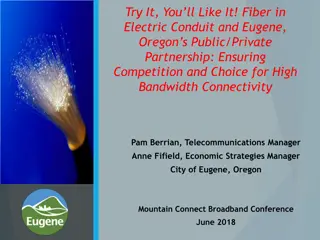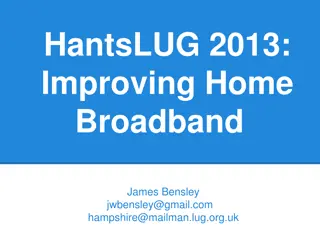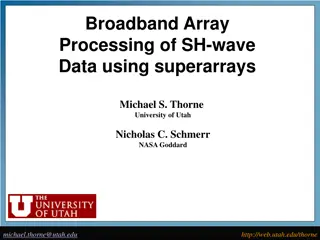Alabama Statewide Broadband Mapping Program Overview
The Alabama Statewide Broadband Mapping Program, led by ADECA and CTC Technology & Energy, aims to identify unserved areas lacking 25/3 coverage and key locations without broadband access. The program encourages collaboration with ISPs, data sharing, and efficient broadband planning to avoid conflicts and improve connectivity in the state.
Download Presentation

Please find below an Image/Link to download the presentation.
The content on the website is provided AS IS for your information and personal use only. It may not be sold, licensed, or shared on other websites without obtaining consent from the author.If you encounter any issues during the download, it is possible that the publisher has removed the file from their server.
You are allowed to download the files provided on this website for personal or commercial use, subject to the condition that they are used lawfully. All files are the property of their respective owners.
The content on the website is provided AS IS for your information and personal use only. It may not be sold, licensed, or shared on other websites without obtaining consent from the author.
E N D
Presentation Transcript
Alabama Statewide Broadband Mapping Program Alabama Department of Economic and Community Affairs (ADECA) Karen White, CTC Technology & Energy Vice President, Client Solutions Elaine Fincannon, ADECA Deputy Director Shawn Thompson, CTC Technology & Energy Vice President, Analytics Maureen Neighbors, ADECA Energy Division Chief Ryland Sherman, CTC Technology & Energy Senior Analyst Chris Murphy, ADECA Program Manager Ara Casey, CTC Technology & Energy Project Coordinator July 1, 2021
Agenda Statewide Mapping Program Overview ISP Data Request Format and Content Data Sharing Agreement Location Review and Challenge Process Q&A
Statewide Broadband Mapping Program Goals and Objectives Identify Tool for Serving Unserved Areas Supports Collaboration with ADECA and Among ISPs Unserved Areas Identify the remaining areas lacking 25/3 coverage Identify areas yet to be built using funds from current programs (Alabama and federal) Identify key locations and anchor institutions lacking broadband Help to improve broadband planning efforts Encourage participation by minimizing ISP effort Prepare ISPs for the FCC mapping requests Data sharing by both ADECA and ISPs builds a viable map Help to avoid future conflicts between ISPs and between an ISP and the State
Public-Facing Map Served and unserved addresses within census blocks A served census block shown Has 80% of addresses within the census block served by 25/3 or better Can be a combination of two of more ISPs within the census block Designates technology - wireline, mobile, fixed wireless, satellite Areas funded by other programs (ADECA Accessibility Program, RDOF, ReConnect, etc.) Anchor institutions No ISP details
Internal-Facing Map All layers in public-facing map ISP detail within census block List of ISPs who serve Highest speed associated with each ISP Latency performance Will be used by ADECA for Policy guidelines Investment decisions
Data Sharing Request Process Simple spreadsheet Simplified version of what you will be required to submit to the FCC for the Digital Opportunity Data Collection (DODC) program Address-based information ADECA provides the addresses estimated to be within your service area You provide: Corrected address list (add/delete addresses) Technology type Maximum download speed in Mbps Maximum upload speed in Mbps Whether latency is less than or greater than 100 ms Protected by a Data-Sharing/Non-Disclosure Agreement (DSA)
Data Request Format Spreadsheet-based data submission with standardized addresses and other information pre-populated by ADECA CensusBlock StreetAddress Unit City State Zip Additional data provided by the ISP directly in the spreadsheet TechCode MaxDownload MaxUpload Latency100ms This initial data request closely resembles the FCC s Digital Opportunity Data Collection Program, but with fewer requirements for ISPs
Data Requested from ISPs Similar to Current FCC Requirements TechCode - Category of technology for the provision of Internet access service used by the portion of the connection that would terminate at the end-user location (premises). MaxDownload - The maximum download speed in Mbps that is currently available at the specified location or that can be made available at that address within 10 days upon customer request with no additional installation cost to end user MaxUpload - The maximum upload speed in Mbps that is currently available at the specified location or that can be made available at that address within 10 days upon customer request with no additional installation cost to end user Latency100ms - Whether the network round-trip latency associated with each maximum speed combination reported for a particular address is less than or equal to 100 ms, based on the 95th percentile of measurements
Using the FCCs TechCode Categories, Plus Mobile Wireless Asymmetric xDSL ADSL2, ADSL2+ VDSL Symmetric xDSL Other Copper Wireline (all copper- wire based technologies other than xDSL; Ethernet over copper and T-1 are examples) Terrestrial Fixed Wireless Mobile Wireless 4G LTE Mobile Wireless 5G Mobile Wireless - Other Cable Modem DOCSIS 1, 1.1 or 2.0 Cable Modem DOCSIS 3.0 Cable Modem DOCSIS 3.1 Cable Modem DOCSIS 4.0 Cable Modem other than DOCSIS 1, 1.1, 2.0, 3.0, 3.1 or 4.0 Optical Carrier / Fiber to the end user (Fiber to the home or business end user, does not include fiber to the curb ) Electric Power Line Satellite Other If different technologies could be used in the two directions of information transfer (downstream and upstream), connection in the technology category for the downstream direction should be provided. All Other
Data Sharing/Non-Disclosure Agreement Must be executed by both you and ADECA prior to the State s data request submission Voluntary disclosure of data to ADECA Mutual confidentiality ISP will protect address level information and not use address data for any other purpose State will protect address level performance data and ISP company information, and will not use data for any other purpose Defines what will be made public Address-specific information from you will be used for the development, refinement, and maintenance of the Mapping Program
Map Data Location Review and Challenges 13
Location Review / Challenge Process Based on FCC s Digital Opportunity Data Collection (DODC) Challenge Process Individual Address or Multi-Address Challenge ADECA Performs Cursory Review 30-Day Period to Address Challenge 30-Day Period to Submit Proof
Location Review / Challenge Process Individual Address or Multi-Address Challenge 30-Day Period to Address Challenge ADECA Performs Cursory Review 30-Day Period to Submit Proof Multi-address challenges Complete form Provide info about methods used to identify availability Individual address challenges Complete form Provide evidence of contacting ISP(s and been denied service at claimed speed (screengrabs, records, etc.)
Location Review / Challenge Process Individual Address or Multi-Address Challenge 30-Day Period to Address Challenge ADECA Performs Cursory Review 30-Day Period to Submit Proof Multi-address challenges Complete form on website Provide info about methods used to identify availability Individual address challenges Complete form on website Provide evidence of contacting ISP(s) and been denied service at claimed speed (screengrabs, records, etc.) ADECA Reviews submission for completeness Evaluates merit of challenge Challenger s data must meet minimum burden of proof Notifies challenged ISP Provides challenger and challenged ISP with next steps
Location Review / Challenge Process Individual Address or Multi-Address Challenge 30-Day Period to Address Challenge ADECA Performs Cursory Review 30-Day Period to Submit Proof ADECA Reviews submission for completeness Evaluates merit of challenge Challenger s data must meet minimum burden of proof Notifies challenged ISP Provides challenger and challenged ISP with next steps Challenged ISP cooperates with challenger or disputes challenge Challenged ISPs are encouraged to work with challenger Once notified, challenged ISP Has 30 days to respond with an agreed to solution Or the challenge is shown on the map Multi-address challenges Complete form on website Provide info about methods used to identify availability Individual address challenges Complete form on website Provide evidence of contacting ISP(s) and been denied service at claimed speed (screengrabs, records, etc.)
Location Review / Challenge Process Individual Address or Multi-Address Challenge 30-Day Period to Address Challenge ADECA Performs Cursory Review 30-Day Period Submit Proof Multi-address challenges Complete form on website Provide info about methods used to identify availability Individual address challenges Complete form on website Provide evidence of contacting ISP(s) and been denied service at claimed speed (screengrabs, records, etc.) ADECA Reviews submission for completeness Evaluates merit of challenge Challenger s data must meet minimum burden of proof Notifies challenged ISP Provides challenger and challenged ISP with next steps Challenged ISP cooperates with challenger or disputes challenger Challenged ISPs are encouraged to work with challenge Once notified, challenged ISP Has 30 days to respond with an agreed to solution Or the challenge replaces prior data Challenged ISP submits proof of its initial service claim; may include Engineering diagrams Network equipment info Proof of service at claimed speeds Confidential elements may include Evidentiary documents Strategic info Some discussions ADECA evaluates and makes decision after 30 days Results incorporated in map
Thank you! Maureen.Neighbors@adeca.alabama.gov kwhite@ctcnet.us sthompson@ctcnet.us A recording of this workshop will be available on the ADECA Broadband Alabama website. https://adeca.alabama.gov/broadband/
